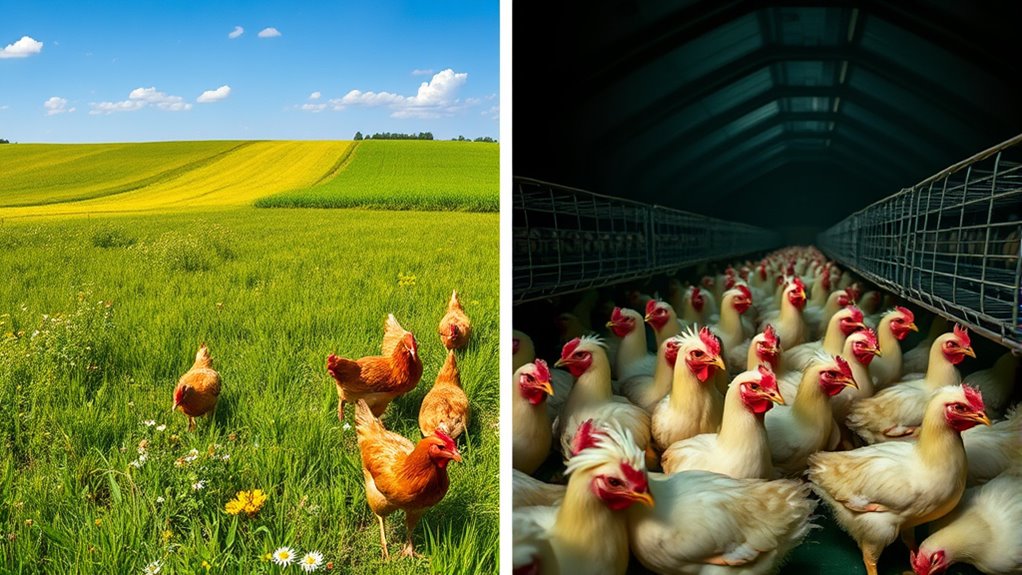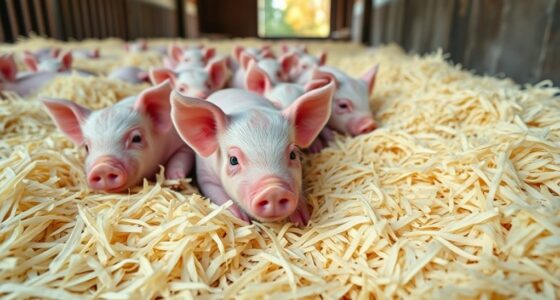When considering free-range versus caged chickens, you'll find free-range systems promote better animal welfare, allowing hens to roam and exhibit natural behaviors. This leads to eggs that often have superior nutritional profiles, including higher omega-3 fatty acids. On the other hand, caged chickens are cheaper but face severe limitations on movement and health. The price difference reflects these welfare concerns. Want to discover more about the implications and benefits of each system?
Key Takeaways
- Free-range chickens have better living conditions, allowing natural behaviors like foraging, leading to improved health and wellbeing compared to caged hens.
- Eggs from free-range hens are generally richer in nutrients, containing higher omega-3 fatty acids and vitamin D than those from caged systems.
- Caged chicken farming is more economical, resulting in lower egg prices, but raises significant animal welfare concerns due to confinement.
- Free-range systems require more land and can lead to environmental challenges, such as land degradation if not managed properly.
- Caged hens often face health issues from confinement, while free-range hens experience a higher quality of life and longer lifespans.
Understanding Free-Range Chickens
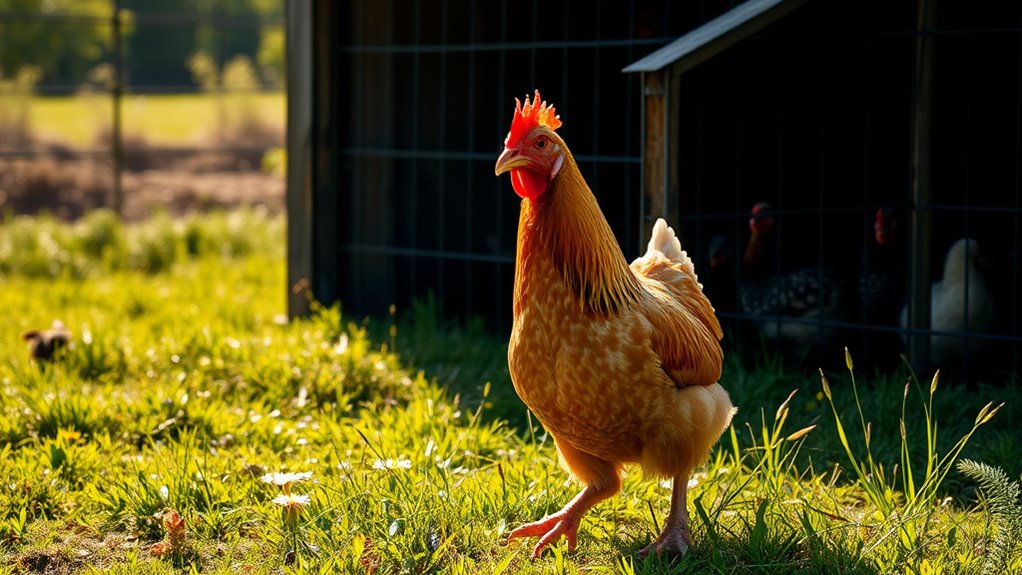
When you consider free-range chickens, you're looking at a farming practice that offers these birds access to outdoor spaces where they can express natural behaviors.
Free-range hens typically enjoy better conditions than caged hens, with a minimum space requirement of around 2 square feet per hen outdoors, as outlined by Certified Humane standards. This access to outdoor areas allows them to forage, leading to a more natural diet rich in nutrients.
These egg-laying hens can socialize freely, promoting higher animal welfare standards. However, it's crucial to note that free-range hens can face challenges, such as predators and varying quality of outdoor space, which may impact their overall well-being.
Prioritizing these factors can help guarantee healthier and happier hens.
The Reality of Caged Chickens
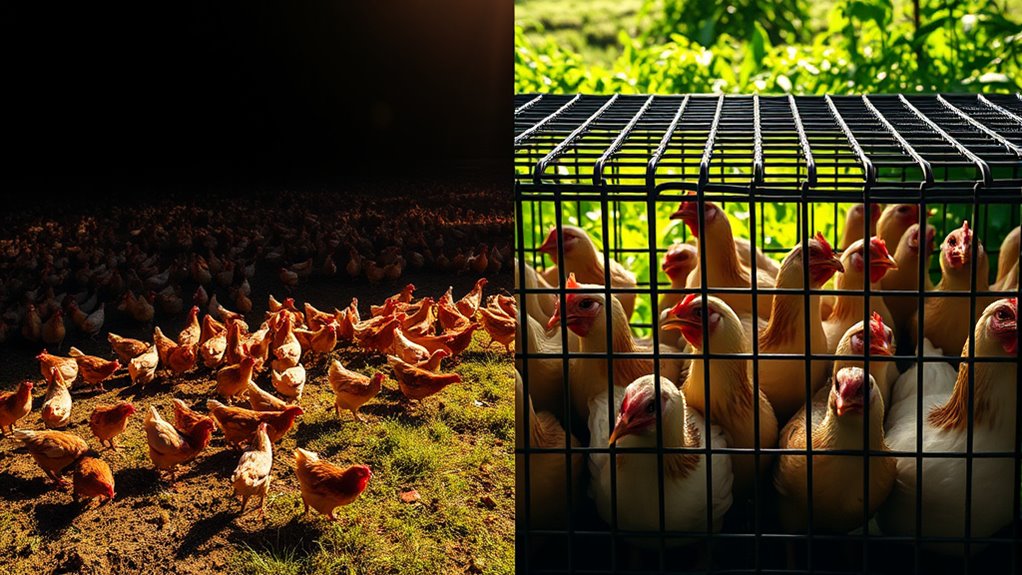
While many people may not realize it, the reality for caged chickens is often grim. Approximately 8.3 billion egg-laying hens are confined to battery cages smaller than an A4 sheet of paper, severely restricting their natural behaviors like foraging and dust bathing.
Caged hens endure high levels of physical and psychological stress due to these movement restrictions, leading to practices such as de-beaking to prevent self-harm. They lay about 300 eggs per year, a stark increase from their wild ancestors.
Unfortunately, the lifespan of these hens is only 60 to 80 weeks before slaughter, often accompanied by suffering from fractures and diseases. Even switching to enriched cages doesn't fully eliminate the welfare issues inherent in caged systems.
Welfare Implications of Each System

When you compare free-range and caged systems, the difference in space availability is striking.
Free-range hens enjoy the outdoors and can engage in natural behaviors, while caged hens are often confined, limiting their movement and social interaction.
Understanding these welfare implications is vital for making informed choices about egg production systems.
Space Availability Comparison
The space available to hens in different farming systems plays an essential role in their welfare.
Cage-free hens typically get a minimum of 1 square foot of indoor space, which can lead to cramped conditions and potential aggressive behavior.
In contrast, free-range hens enjoy at least 2 square feet of outdoor space, allowing them to exhibit more natural behaviors like foraging and socializing.
This increased space availability not only promotes healthier interactions but also enhances overall welfare.
Studies show that free-range systems lead to considerably lower levels of pain and distress compared to cage systems.
Ultimately, the welfare implications of these production systems are clear: more space fosters better health and wellbeing for hens.
Natural Behaviors Support
Natural behaviors are essential for the welfare of hens, and the differences between free-range and caged systems greatly impact their ability to express these behaviors.
Free-range hens benefit from outdoor space, allowing them to forage, dust bathe, and socialize, which are vital for their well-being. In contrast, cage-free systems offer some movement indoors but lack outdoor access, limiting natural behaviors.
Although cage-free environments reduce pain and discomfort compared to battery cages, they still don't match the welfare benefits of free-range systems.
Studies show that free-range hens typically enjoy better overall welfare, as they can roam freely and engage in natural behaviors, leading to healthier and happier hens—and ultimately, better quality eggs for you.
Nutritional Differences Between Egg Types
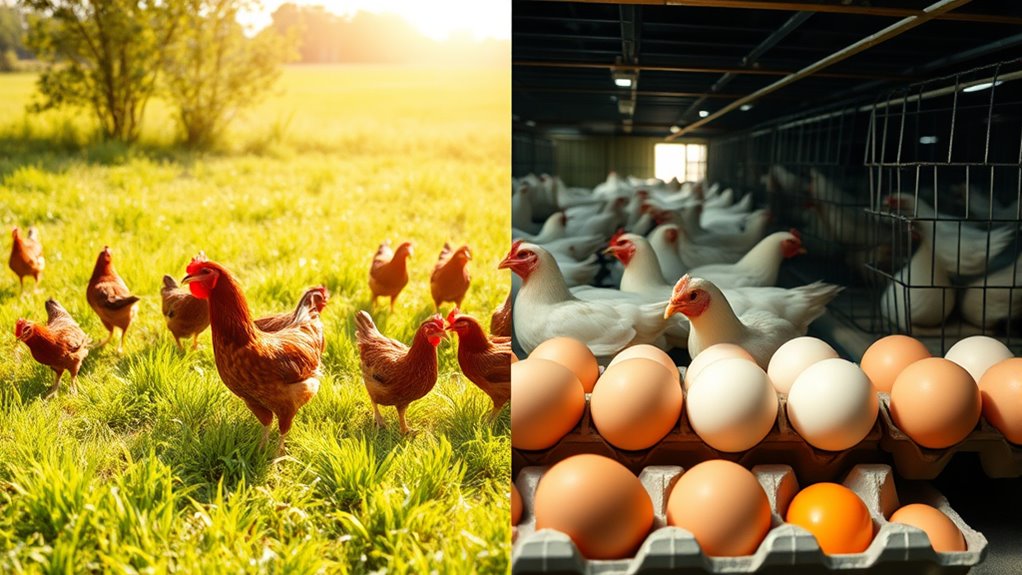
While many people enjoy eggs as a staple in their diet, the nutritional differences between free-range and caged chickens can greatly impact the quality of the eggs you consume.
Free-range eggs typically have higher levels of omega-3 fatty acids and vitamin D, thanks to hens foraging outdoors. Eggs from pasture-raised hens often boast richer yolk color and enhanced nutritional profiles, reflecting their diverse diets.
Additionally, some studies indicate that free-range eggs may have lower cholesterol levels compared to caged varieties. The mineral content also varies; organic and free-range systems generally yield eggs with higher mineral concentrations.
Ultimately, while all eggs are a good protein source, free-range and pasture-raised options may offer superior nutrients to boost your health.
Economic Considerations for Consumers
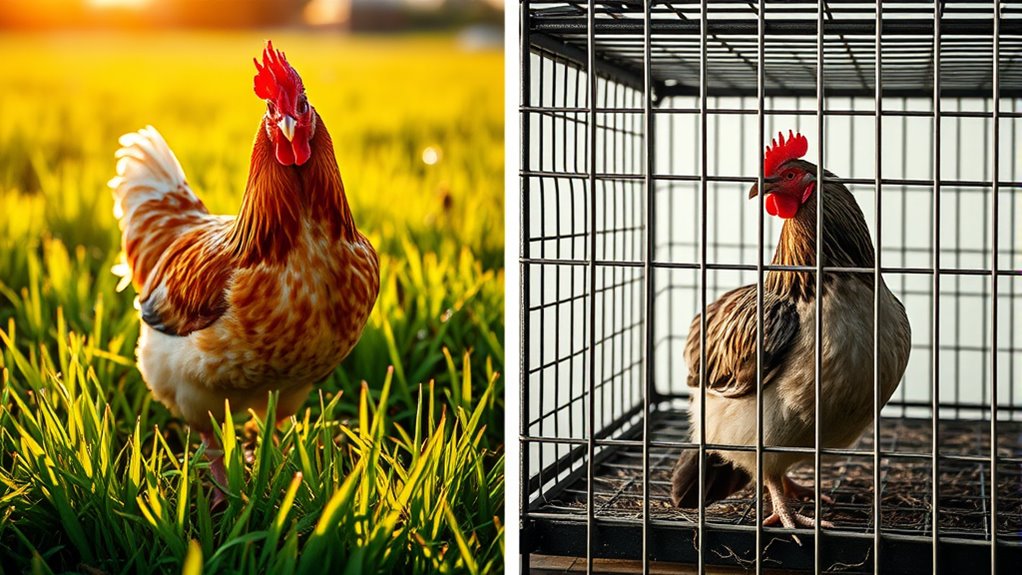
When choosing eggs, price often plays a significant role in your decision-making process. Understanding the economic implications can help you navigate your options:
- Conventional Caged Eggs: Typically the cheapest, associated with lower production costs.
- Cage-Free Eggs: Generally more expensive, reflecting humane treatment and space requirements.
- Free-Range and Pasture-Raised Eggs: Costlier due to hens having access to outdoor space, aligning with consumer demand for ethical practices.
- Price Differences: These reflect varying levels of care for hens, impacting your consumer choices based on ethical considerations.
Ultimately, while the egg industry offers a range of prices, investing in humane treatment can lead to a more informed and responsible purchase.
Making Informed Choices for Egg Purchases
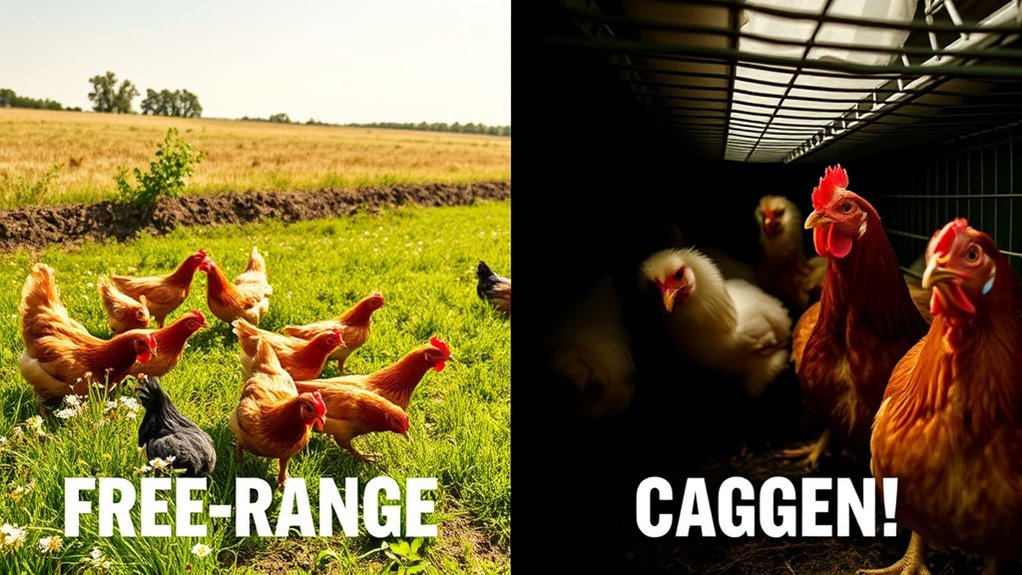
When you're shopping for eggs, understanding labels is key to making informed choices.
Look for certifications that guarantee higher welfare standards, and remember that price often reflects ethical considerations.
Understanding Egg Labels
How can you make informed choices when buying eggs? Understanding egg labels is essential to guarantee you're getting what you expect.
Here are four key points to take into account:
- Cage-Free: Hens aren't caged and can move freely indoors, but they mightn't have outdoor access.
- Free-Range: These hens have access to the outdoors, but the quality and size of that outdoor space can vary.
- Welfare Standards: Look for certifications like "Certified Humane" that guarantee better living conditions, including space and outdoor access.
- Misleading Labels: Terms like "vegetarian-fed" can be misleading, as they don't always reflect the hens' natural diets.
Animal Welfare Standards
Understanding animal welfare standards is essential for making informed choices about egg purchases, especially since not all labels tell the full story.
Cage-free hens have more space than those in battery cages, but often lack outdoor access, leading to cramped living conditions.
On the other hand, free-range hens do have outdoor access, but the quality and size of that space can vary considerably between farms.
To promote better welfare, look for eggs that are certified humane or welfare approved.
Remember, just because eggs are labeled "cage-free" or "free-range," it doesn't guarantee ideal living conditions. Hens must have the opportunity to roam freely and experience quality outdoor time for their well-being.
Your choices can greatly impact their lives.
Price vs. Ethics
Steering through the intersection of price and ethics in egg purchases can feel overwhelming, but it's essential for making choices that align with your values.
Here's a quick guide to help you navigate:
- Caged Eggs: The cheapest option, but often at the cost of animal welfare.
- Cage-Free: Slightly higher price, reflecting better humane treatment, but still limited space.
- Free-Range: More expensive, offering hens outdoor access, aligning with consumer demand for ethical practices.
- Pasture-Raised: The priciest choice, ensuring high animal welfare standards with ample space for foraging.
Frequently Asked Questions
Is Free Range or Cage-Free Better for Chickens?
When you consider whether free-range or cage-free is better for chickens, you'll find that free-range systems generally offer hens more outdoor access, allowing them to exhibit natural behaviors.
This environment can enhance their overall welfare and potentially improve egg quality.
Cage-free systems, while better than battery cages, still limit some natural behaviors and can lead to stress among hens.
Ultimately, if you prioritize animal welfare, free-range might be the preferable choice for you.
What Is the Downside to Free-Range Chickens?
When you think of free-range chickens, you might picture happy birds roaming freely.
However, there are some challenges. You'll find that they can be more vulnerable to predators and may wander off, making it tough to keep track of them.
Plus, their droppings can create hygiene issues, and they might damage your garden while foraging.
Collecting eggs can turn into a treasure hunt, as hens sometimes hide their nests in hard-to-reach spots.
What Are the Pros and Cons of Caged Chickens?
When considering caged chickens, you'll find some pros and cons.
On the plus side, caged systems are cost-effective, leading to lower egg prices for consumers.
However, the downsides are significant; these chickens face severe confinement, which limits their natural behaviors and often leads to physical and psychological stress.
You might also notice concerns about their welfare, as studies show they experience more suffering compared to those in more humane environments.
Is Free Range Chicken Actually Healthier?
Yes, free-range chicken is often healthier for you.
Since these chickens forage for a diverse diet, their eggs can contain higher levels of nutrients like omega-3 fatty acids and vitamin D. You might notice that free-range eggs have a richer flavor and deeper yolk color too.
Plus, the natural behaviors and exercise of free-range chickens can lead to better overall meat quality, making them a nutritious choice for your meals.
Conclusion
As you weigh the pros and cons of free-range versus caged chickens, consider what truly matters to you. Will you prioritize animal welfare, nutritional value, or your budget? Each egg you choose holds a story, a hidden impact on the world around you. What if the next time you crack an egg, it could change your perspective entirely? The choice is yours, but remember: the future of our food system lies in the decisions you make today.

